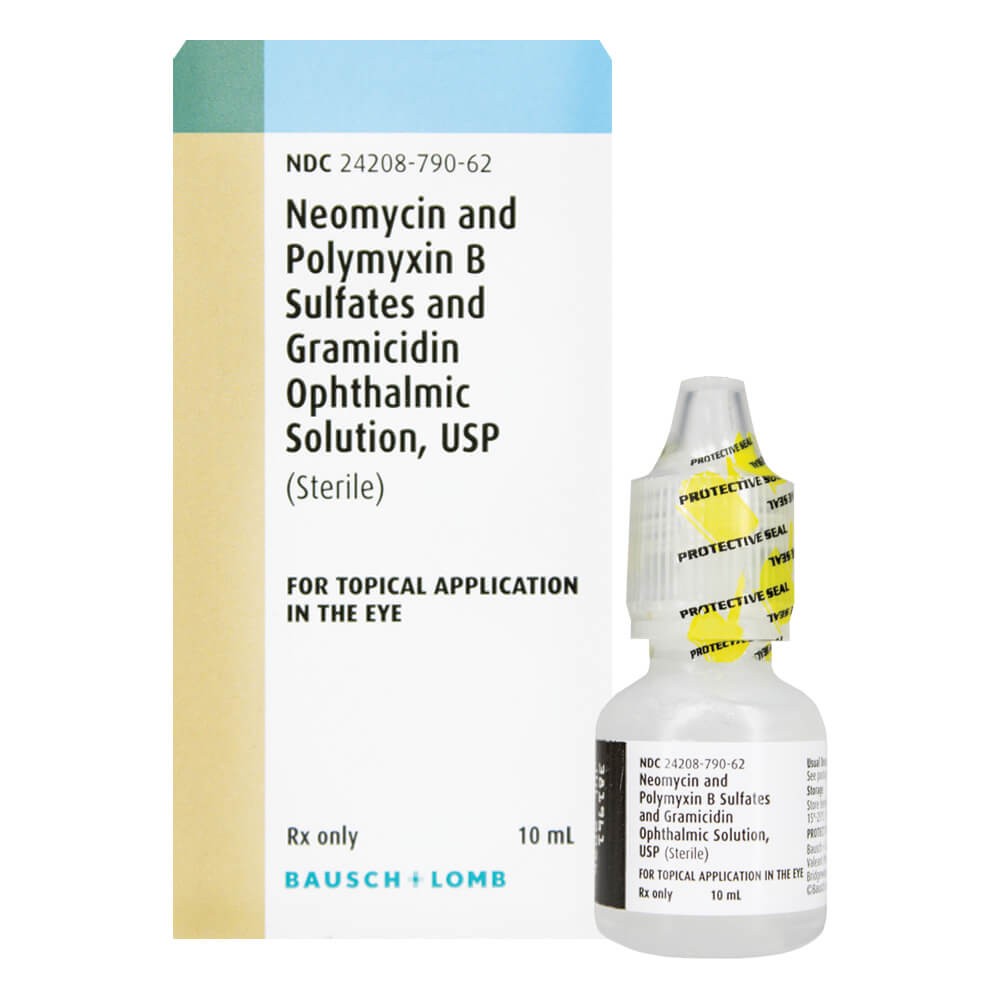
Contents
neomycin/polymyxin
Neomycin/polymyxin B/gramicidin ophthalmic is an antibiotic eye drop used for treating superficial eye infections and inflammations. It is a combination of three antibiotics that collectively offer a wider range of bacteria targeting than any one as a standalone agent.
The three antibiotics work differently to either inhibit bacterial growth or kill bacteria:
- Neomycin: Broad-spectrum aminoglycoside antibiotic that kills both gram-positive and gram-negative bacteria. It hinders protein synthesis in bacteria and causes damage to the cell wall, leading to bacterial death.
- Polymyxin B: Bactericidal drug that binds to fatty molecules on the outer cell membranes of gram-negative bacteria. It increases cell membrane permeability, resulting in leakage of cell contents and bacterial death.
- Gramicidin: Inserts itself into bacterial membranes, enhancing permeability and causing leakage of cell contents. It also disrupts bacterial metabolic functions, protein synthesis, and DNA functions, resulting in bacterial death. Particularly effective against gram-positive bacteria.
This combination is effective against both gram-positive and gram-negative bacteria. Gram-negative bacteria have an extra membrane outside the cell wall that is absent in gram-positive bacteria. Bacteria susceptible to this combination include:
- Staphylococcus aureus
- Streptococci, including Streptococcus pneumoniae
- Escherichia coli
- Haemophilus influenzae
- Klebsiella-Enterobacter species
- Neisseria species
- Pseudomonas aeruginosa
Neomycin/polymyxin B/gramicidin ophthalmic is used to treat various types of eye infections:
- Infection of the conjunctiva (conjunctivitis)
- Infection of the cornea (keratitis)
- Keratoconjunctivitis
- Eyelid infection (blepharitis)
- Blepharoconjunctivitis
Warnings
- Avoid use if allergic to neomycin, aminoglycosides, or any component of the solution.
- Allergic cross-reactions may occur, preventing the use of certain antibiotics in the future.
- Do not inject the solution into the eye.
- Monitor for neomycin sensitization symptoms, including itching, redness, edema, and failure to heal.
- Prolonged use can result in diminished visual acuity, posterior subcapsular cataract formation, and glaucoma. Overgrowth of non-susceptible organisms and development of bacterial resistance may also occur.
Side Effects
Common side effects include:
- Local eye irritation
- Ocular reactions like swelling, itching, and redness
- Hives, vesicular and maculopapular dermatitis
- Swelling of tissue beneath the skin and mucous membranes (angioedema)
- Severe allergic reactions (anaphylaxis)
Contact your doctor immediately if you experience serious side effects such as heart symptoms, severe headache, confusion, severe nervous system reaction, or serious eye symptoms.
This is not an exhaustive list of side effects or adverse reactions. Contact your doctor or report side effects to the FDA.
Dosages
Ophthalmic solution:
- (1.75 mg/10,000/0.025 mg)/1 mL (10 mL)
Adult and Pediatric:
Treatment and Prevention of Ocular Infection and/or Inflammation:
- 1-2 drops every 4-6 hours for 7-10 days; if severe, 2 drops every 1 hour if necessary
Overdose:
No information is available regarding overdose. Oral ingestion and overdose may be harmful. Overgrowth of non-susceptible organisms and development of bacterial resistance may occur. Discontinue use and seek appropriate medical treatment.
Drug Interactions
Inform your doctor of all medications you are currently taking to determine possible drug interactions. Do not change your medication without your doctor’s recommendation.
Some severe interactions include:
- Aminoglycosides
- Bacitracin
- BCG intravesical
- Choleravaccine
- Fecal microbiota (live) oral
- Fecal microbiota (live) rectal
- Mecamylamine
- Methoxyflurane
- Netilmicin ophthalmic
- Bacillus clausii
- Colistimethate
- Kanamycin
- Neuromuscular blocking agents
- Sodium picosulfate
- Typhoid vaccine
- BCG vaccine
- Capreomycin
- Cefazedone
- Cephaloridine
- Immune checkpoint inhibitors (anti-PD-1, -PD-L1, and -CTLA4 therapies)
- Lactobacillus and estriol
It is important to inform your healthcare provider about all medications you use, including prescription and over-the-counter drugs, to avoid adverse effects or interactions.
Pregnancy and Breastfeeding
- No animal studies have been conducted on the safety of neomycin/polymyxin B/gramicidin ophthalmic during pregnancy. Use in pregnant women is only recommended if necessary.
- It is unknown if the medication passes into breast milk. Use caution while nursing, as many drugs are excreted in breast milk.
Additional Information
- Follow the instructions for neomycin/polymyxin B/gramicidin ophthalmic exactly as directed.
- Apply the solution topically to the eye only.
- Do not share your eye drop dispenser to prevent spreading infection.
- Avoid the tip of the solution container from contacting any surface to prevent contamination. Use of contaminated eyedrops may result in infections, eye damage, and vision loss.
- Exercise caution to avoid injury to the eye from contact with the container tip.
- Complete the full course of antibiotics. Do not skip doses or discontinue treatment prematurely, as it may reduce effectiveness and lead to drug-resistant bacteria.
- Discontinue use and consult a physician if you develop hypersensitivity reactions, experience prolonged symptoms, or if your condition worsens.
- By clicking Submit, you agree to the MedicineNet’s Terms & Conditions & Privacy Policy and understand that you may opt out of MedicineNet’s subscriptions at any time.
Summary
Neomycin/polymyxin B/gramicidin ophthalmic is an antibiotic eye drop used for treating superficial eye infections and inflammations. It is effective against various eye infections, including conjunctivitis, keratitis, keratoconjunctivitis, blepharitis, and blepharoconjunctivitis. Common side effects include irritation, swelling, itching, skin redness, hives, and severe allergic reactions.


